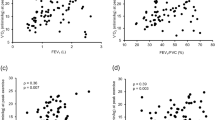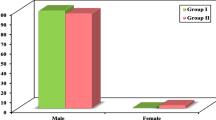Abstract
During exercise testing, patients with chronic obstructive pulmonary disease (COPD) often present with ventilatory limitations and various combinations of impaired peripheral oxygenation (IPO) to the exercising muscles. The entities of IPO include anemia, circulation impairment and deconditioning. COPD-IPO is not widely accepted as being a subgroup of COPD. Therefore, the aim of this study was to evaluate the clinical features of COPD-IPO patients. Forty-seven COPD patients underwent cardiopulmonary exercise testing. COPD-IPO was identified when all IPO variables had abnormal values. The patients who did not meet the COPD-IPO criteria were defined as the NIPO group. The variables with abnormal values included peak oxygen uptake (\( {\dot{\text{V}}\text{O}}_{ 2} \)) <85 % predicated, anaerobic threshold <40 %\( {\dot{\text{V}}\text{O}}_{{ 2 {\text{max}}}} \) pred, \( {\dot{\text{V}}\text{O}}_{ 2} \)-work rate slope <8.6 ml/watt, oxygen pulse <80 %pred, and ventilatory equivalents for O2 and CO2 at nadir (>31 and >34, respectively). Anthropometrics, biochemistry, and lung function were compared between the groups. Forty-six COPD patients were enrolled after excluding one patient who had technical difficulties in performing the exercise tests. Despite FEV1 and FVC being similarly reduced (p = NS) between the groups, the COPD-IPO (n = 13, 28 %) patients had lower body mass index and were taller, and had impaired diffusing capacity and larger total lung capacity and air-trapping (all p < 0.05). We concluded that COPD patients with all six variables having abnormal values are a unique subgroup and that identification of these patients is worthwhile for further investigations and management such as exercise training and nutritional supplements.

Similar content being viewed by others
References
Wasserman K, Hansen JE, Sue DY, Stringer WW, Whipp BJ (2005) Principles of interpretation: A flowchart approach. In: Wasserman K (ed) Principles of exercise testing and interpretation. Lippincot Williams & Wilkins, Philadelphia, pp 183–197
This Joint Statement of the ATS and the ACCP was adopted by the ATS Board of Directors M, 2002 and by the ACCP Health Science Policy Committee, November 1, 2001 (2003) ATS/ACCP Statement on cardiopulmonary exercise testing. Am J Respir Crit Care Med 167:211–277
Weatherall M, Shirtcliffe P, Travers J, Beasley R (2010) Use of cluster analysis to define COPD phenotypes. Eur Respir J 36:472–474
Lan CC, Yang MC, Lee CH, Huang YC, Huang CY, Huang KL, Wu YK (2011) Pulmonary rehabilitation improves exercise capacity and quality of life in underweight patients with chronic obstructive pulmonary disease. Respirology 16:276–283
GOLD C (2011) Global strategy for the diagnosis, management, and prevention of chronic obstructive pulmonary disease (revised 2011) Disclosure forms for GOLD Committees are posted on the GOLD Website, http://www.goldcopdorg
McGavin CR, Artvinli M, Naoe H, McHardy GJ (1978) Dyspnoea, disability, and distance walked: comparison of estimates of exercise performance in respiratory disease. Br Med J 2:241–243
Jones NL (1988) Normal standards, 3rd edn. WB Saunders, Philadelphia
Chetty KG, Brown SE, Light RW (1982) Identification of pulmonary hypertension in chronic obstructive pulmonary disease from routine chest radiographs. Am Rev Respir Dis 126:338–341
Bertoli L, Mantero A, Cicero SL, Alpago R, Rizzato G, Belli C (1985) Usefulness of two-dimentional echocardiography in the assessment of right heart in chronic obstructive lung disease: progress in respiration research. Basel Karger 20:91–100
Danchin N, Cornette A, Henriquez A, Godenir JP, Ethevenot G, Polu JM, Sadoul P (1987) Two-dimensional echocardiographic assessment of the right ventricle in patients with chronic obstructive lung disease. Chest 92:229–233
ATS/ERS (2002) ATS/ERS Statement on respiratory muscle testing. Am J Respir Crit Care Med 166:518–624
Miller MR, Crapo R, Hankinson J, Brusasco V, Burgos F, Casaburi R, Coates A, Enright P, van der Grinten CP, Gustafsson P, Jensen R, Johnson DC, MacIntyre N, McKay R, Navajas D, Pedersen OF, Pellegrino R, Viegi G, Wanger J (2005) General considerations for lung function testing. Eur Respir J 26:153–161
Miller MR, Hankinson J, Brusasco V, Burgos F, Casaburi R, Coates A, Crapo R, Enright P, van der Grinten CP, Gustafsson P, Jensen R, Johnson DC, MacIntyre N, McKay R, Navajas D, Pedersen OF, Pellegrino R, Viegi G, Wanger J (2005) Standardisation of spirometry. Eur Respir J 26:319–338
Macintyre N, Crapo RO, Viegi G, Johnson DC, van der Grinten CP, Brusasco V, Burgos F, Casaburi R, Coates A, Enright P, Gustafsson P, Hankinson J, Jensen R, McKay R, Miller MR, Navajas D, Pedersen OF, Pellegrino R, Wanger J (2005) Standardisation of the single-breath determination of carbon monoxide uptake in the lung. Eur Respir J 26:720–735
Wasserman K, Hansen JE, Sue DY, Stringer WW, Whipp BJ (2005) Clinical exercise testing. In: Wasserman K (ed) Principles of exercise testing and interpretation. Lippicott Williams & Wilkins, Philadelphia, pp 133–159
Chuang ML, Lee CH, Lin IF (2010) Using the oxygen-cost diagram in ramp-slope selection for dyspneic patients. Intern Med 49:1325–1332
Sue DY, Wasserman K, Moricca RB, Casaburi R (1988) Metabolic acidosis during exercise in patients with chronic obstructive pulmonary disease. Use of the V-slope method for anaerobic threshold determination. Chest 94:931–938
Wasserman K, Hansen JE, Sue DY, Stringer WW, Whipp BJ (2005) Normal values. In: Wasserman K (ed) Principles of exercise testing and interpretation. Lippincot Williams & Wilkins, Philadelphia, pp 160–182
McNicholl DM, Megarry J, McGarvey LP, Riley MS, Heaney LG (2011) The utility of cardiopulmonary exercise testing in difficult asthma. Chest 139:1117–1123
Zavala D (1987) Manual of exercise testing: a training handbook. Press of the University of Iowa, Iowa pp 51–54
Chuang ML, Lin IF, Vintch JR (2004) Comparison of estimated and measured maximal oxygen uptake during exercise testing in patients with chronic obstructive pulmonary disease. Intern Med J 34:469–474
Hansen JE, Sue DY, Wasserman K (1984) Predicted values for clinical exercise testing. Am Rev Respir Dis 129:S49–S55
Benditt JO, Wood DE, McCool FD, Lewis S, Albert RK (1997) Changes in breathing and ventilatory muscle recruitment patterns induced by lung volume reduction surgery. Am J Respir Crit Care Med 155:279–284
O’Donnell DE, Revill SM, Webb KA (2001) Dynamic hyperinflation and exercise intolerance in chronic obstructive pulmonary disease. Am J Respir Crit Care Med 164:770–777
Vestbo J, Hurd SS, Agusti AG, Jones PW, Vogelmeier C, Anzueto A, Barnes PJ, Fabbri LM, Martinez FJ, Nishimura M, Stockley RA, Sin DD, Rodriguez-Roisin R (2013) Global strategy for the diagnosis, management, and prevention of chronic obstructive pulmonary disease: GOLD executive summary. Am J Respir Crit Care Med 187:347–365
ATS statement (2002) guidelines for the six-minute walk test. Am J Respir Crit Care Med 166:111–117
Bellemare F, Cordeau MP, Couture J, Lafontaine E, Leblanc P, Passerini L (2002) Effects of emphysema and lung volume reduction surgery on transdiaphragmatic pressure and diaphragm length. Chest 121:1898–1910
Miniati M, Monti S, Stolk J, Mirarchi G, Falaschi F, Rabinovich R, Canapini C, Roca J, Rabe KF (2008) Value of chest radiography in phenotyping chronic obstructive pulmonary disease. Eur Respir J 31:509–515
Lan CC, Su CP, Chou LL, Yang MC, Lim CS, Wu YK (2012) Association of body mass index with exercise cardiopulmonary responses in lung function-matched patients with chronic obstructive pulmonary disease. Heart Lung 41:374–381
Palange P, Forte S, Onorati P, Paravati V, Manfredi F, Serra P, Carlone S (1998) Effect of reduced body weight on muscle aerobic capacity in patients with COPD. Chest 114:12–18
Chhabra SK, De S (2004) Clinical significance of hilar thoracic index and width of right descending branch of pulmonary artery in chronic obstructive pulmonary disease. Indian J Chest Dis Allied Sci 46:91–97
Galie` N, Hoeper MM, Humbert M, Torbicki A, Vachiery J-L, Barbera JA, Beghetti M, Corris P, Gaine S, Gibbs JS, Gomez-Sanchez MA, Jondeau G, Klepetko W, Opitz C, Peacock A, Rubin L, Zellweger M, Simonneau G (2012) Guidelines for the diagnosis and treatment of pulmonary hypertension: the Task Force for the Diagnosis and Treatment of Pulmonary Hypertension of the European Society of Cardiology (ESC) and the European Respiratory Society (ERS), endorsed by the International Society of Heart and Lung Transplantation (ISHLT). Eur Respir J 2009;34:1219–1263
Vachiery JL, Gaine S (2012) Challenges in the diagnosis and treatment of pulmonary arterial hypertension. Eur Respir Rev 21:313–320
Acknowledgments
This study was supported in part by the Chang Gung Medical Research Program (CMRP No. 443) and Chung Shan Hospital Research Program (CSHRP No. 11144, CSH-2012-C-023). The authors would like to thank professor Fen-Chiung Lin of Chang Gung Memorial Hospital, Taoyuan, Taiwan, R.O.C. for her excellent performing the two-dimensional echocardiography.
Conflict of interest
None.
Author information
Authors and Affiliations
Corresponding author
Rights and permissions
About this article
Cite this article
Chuang, ML., Lin, IF. Clinical characteristics and lung function in chronic obstructive pulmonary disease complicated with impaired peripheral oxygenation. Intern Emerg Med 9, 633–640 (2014). https://doi.org/10.1007/s11739-013-0989-8
Received:
Accepted:
Published:
Issue Date:
DOI: https://doi.org/10.1007/s11739-013-0989-8




